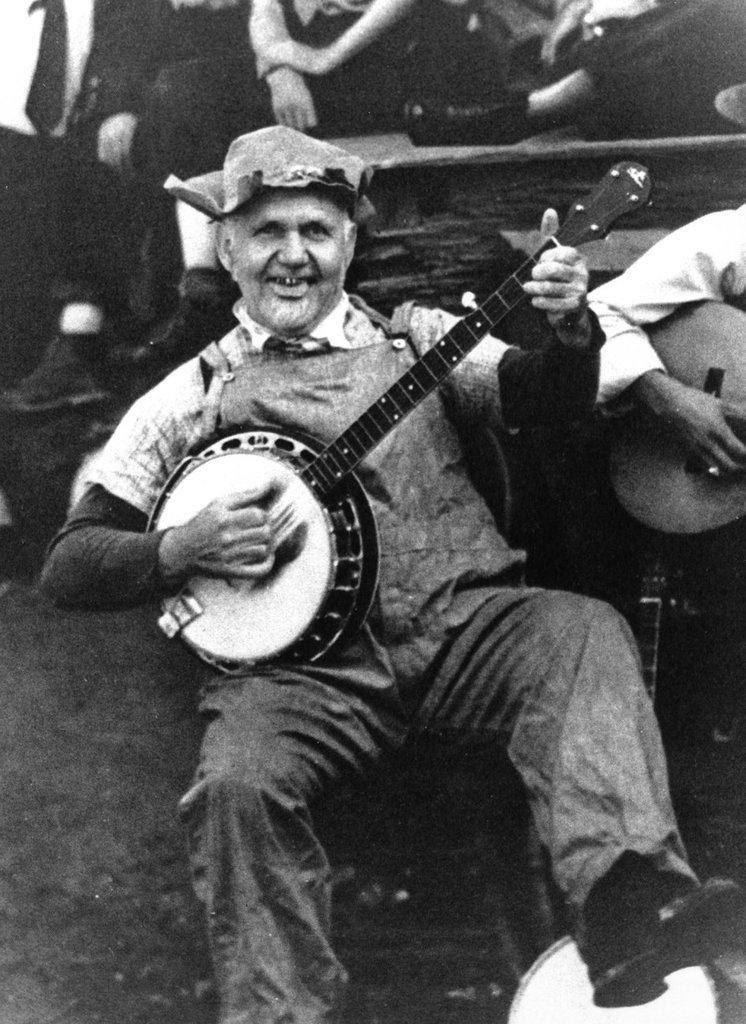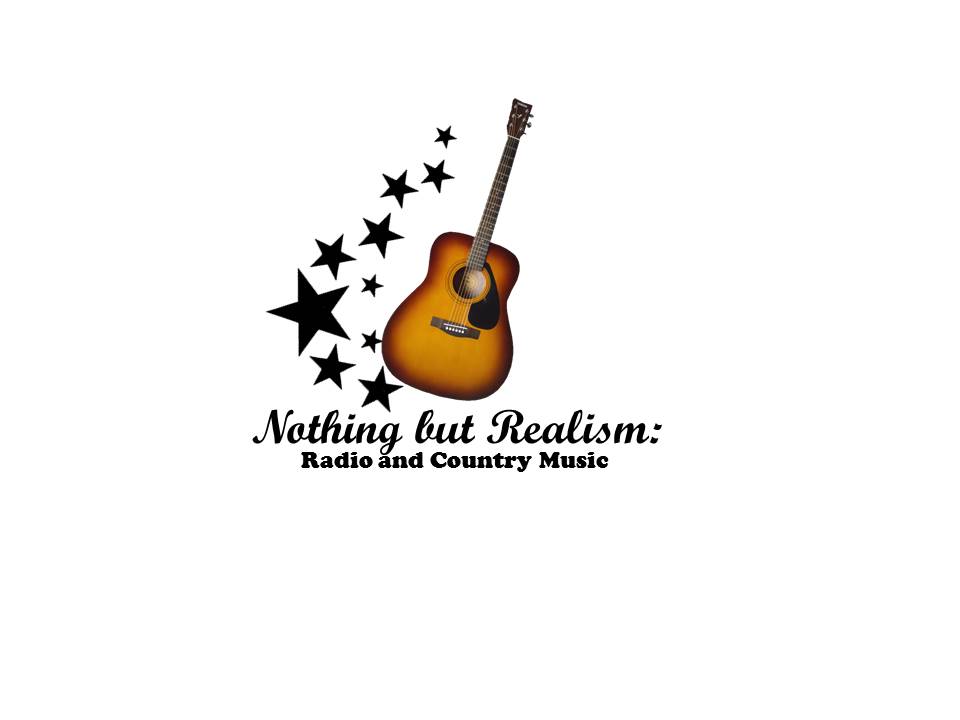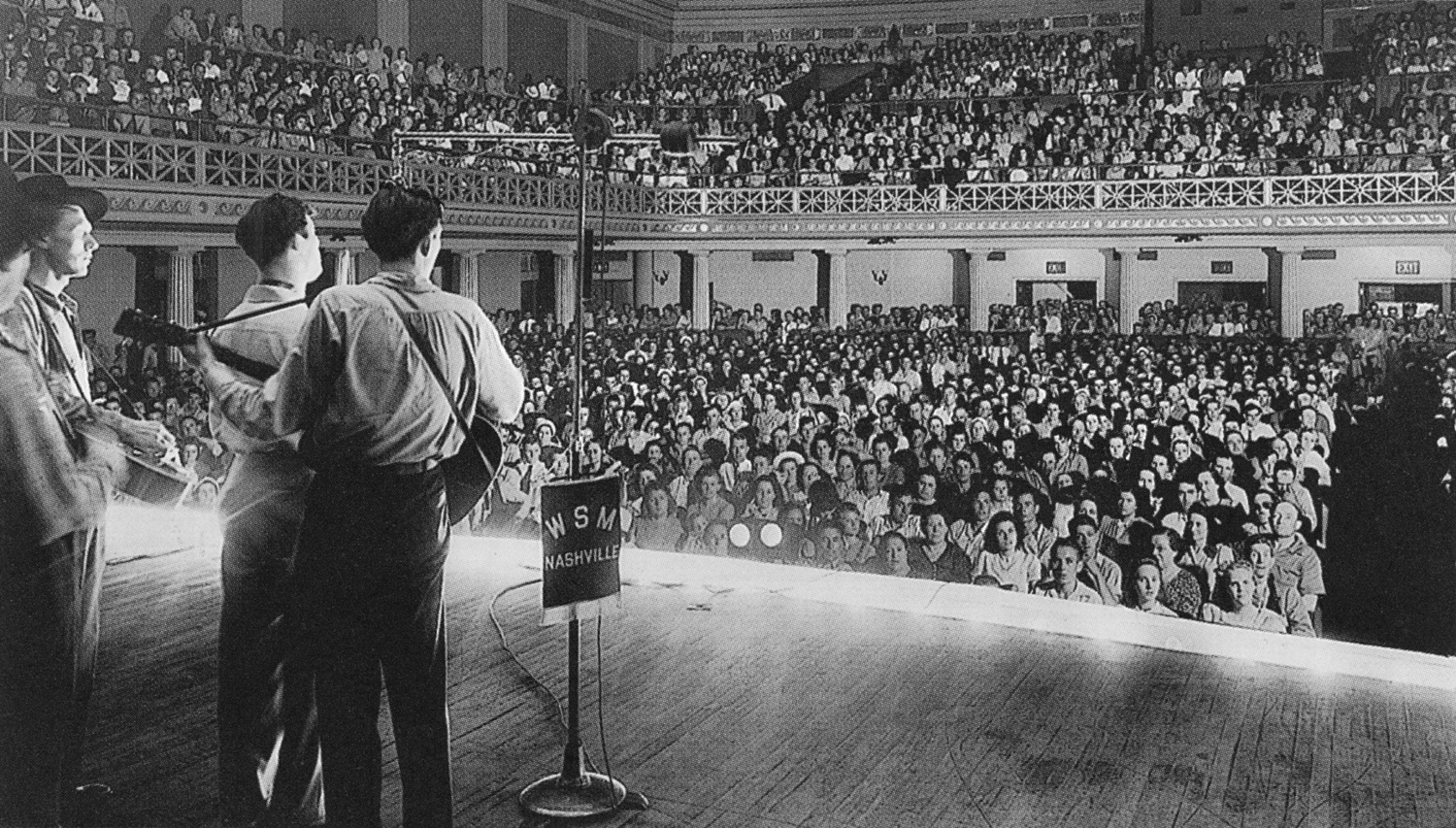Happy Voices: Live Performance


 National Barn Dance Program August 22, 1942 Uncle Dave Macon Artist Profile
National Barn Dance Program August 22, 1942 Uncle Dave Macon Artist Profile  Article: "The Influential Strumming Techniques of Maybelle Carter"
Article: "The Influential Strumming Techniques of Maybelle Carter" During the 1920s and 1930s, live performances on the many fifty-thousand watt radio stations that broadcast country music operated in tandem with individual string band performances to build on the music’s existing audience and increase demand. As that demand grew and portions of those shows made their way onto the national networks, a wider audience came to expand its geographical awareness and appreciation of the variety of musical styles they were hearing.
In addition, live country music over the radio revolutionized performance styles and conditions for those behind the microphone. As Richard A. Peterson reflects, “…Radio performance was the context in which performers had a chance to perfect their skills with other would-be professionals, to become experienced in the ways of commercial entertainment, to attract the attention of record producers, and most important, to become well enough known among the public to make a living playing shows and dances.” In order to do so, performers first had to adjust to the technology, which proved challenging when it was first introduced during the 1920s and 1930s. Some early singers, such as Uncle Dave Macon, found difficulty adapting their craft to accommodate the microphone. Radio performance allowed smaller-voiced singers to emerge when before, a shouting style was used which depended on clearly enunciated words with emotion conveyed through physical gestures. As a result of the adoption of the microphone and broadcasting, the old style became forced, corny, and distinctly old-fashioned, and gave way to a more intricate style of singing in a similar fashion to the crooning that was popular at the time. Comedy, an important element in the country music show, was also affected. Whereas it had previously depended on exaggerated outfits and a broad visual effect, radio gave way to the shift towards one-liners and characters being conveyed through words.
Radio also brought about a change in country music performance demographics. For the first time, youth were given an opportunity to try their hand at establishing viable careers. Indeed, most of the artists drawn to radio during the 1930s were young people who would work for next to nothing while perfecting their craft, and the structure of radio performance networks meant that they had the opportunity to regularly observe and learn from other styles. In addition, working closely with other performers and industry leaders also provided them with instant feedback, which contributed to fluidity within the genre as they adapted and influenced each other. Women, who had been fully involved in pre-commercial country music, had a more mixed experience when the genre began to hit the airwaves. In the 1920s, they found themselves disadvantaged by the low standard in which professional performers were held and a widespread prejudice against women performing in public. Those who tried were met with discrimination unless they were part of family groups, such as Maybelle Carter who toured with the rest of the Carter family. The shift to radio and barn dance format brought about a relative safety which opened the door for women within that support network and saw the development of harmony-singing sister acts.
Within the economic context of the Great Depression, barn dance-style performance also promised a viable source of income and became a goal to aspire to during that decade. Interestingly, National Barn Dance performers did not get paid until a girlfriend of notorious gangster Al Capone was a guest on the show and, after attending the performances, Capone questioned, “Well, don’t she get paid?” Naturally, she did, and other stars quickly started asking for equal treatment. For those performers outside the barn dance networks, making a steady income depended on stamina. Those who “toured out” from radio stations made such modest incomes appearing at schools, town halls, and local theaters that they would fit in as many engagements as humanly possible.
Spotlight: Legendary Institutions
WSB Atlanta: The first high-powered radio station in the South, and possibly the first to feature country music. It was owned by the Atlanta Journal, and went on the air for the first time on March 16, 1922. From then on, it led the way for stations all over the South and Midwest to start showcasing country talent in the early 1920s. As Bill C. Malone writes, “It was only fitting that Atlanta should play this role. Breathing an aura of Old South romance and charm, the city simultaneously suggested the spirit of urbanity and industrial growth that would soon overshadow the old image.”
Barn Dance Radio: The first barn dance show was an hour-and-a-half program of square dance and fiddle music broadcast over WBAP in Fort Worth, Texas in 1923, which had a signal that could be heard as far away as Haiti. Diane Pecknold describes the typical barn dance program as being
“a stylized rendition of the old-fashioned country and comedy selections introduced by a master of ceremonies who was frequently the advertisers’ spokesman. Comedians and musicians alike developed theatrical stock characters that drew on a variety of rural and regional stereotypes. These personalities were usually designed to accord with the act’s specialized performance style: Victorian ladies and small-town sweethearts sang old-time sentimental pop, string bands and rube comedians wore overalls and toted jugs, and clean-scrubbed mountaineers reaffirmed valued folkways. The characters, and frequently the personnel as well, came straight from the vaudeville stage.”
The format of the barn dance program was relatively constant, largely due to the regular exchange of musical and managerial personnel from station to station, but it did allow for the inclusion of regional diversity. The barn dance is one of the most significant elements in the relationship between country music and radio. Pecknold observes:
“One of the most important features of the barn dance, and other hillbilly radio, was its close association, both institutionally and stylistically, with the advent of broadcast advertising…. Hillbilly can reasonably be interpreted as an adjunct of radio broadcast advertising than as a part of the music industry until after World War II.”
WSM Nashville and the Grand Ole Opry
Country music’s oldest and most famous institution got its start on the radio in 1925 but did not earn its name until 1927, when “Solemn Old Judge” George Hay’s old-time music variety show followed NBC’s Music Appreciation Hour on Nashville radio station WSM. Near the end of the classical NBC show, noted conductor Walter Damrosch declared that there was “no place in the classics for realism,” and when Hay’s program came on the air, he responded by proclaiming, “for the last hour, we have been listening to music taken largely from grand opera and the classics, and heard Dr. Damrosch tell us there is no place for realism in that kind of music. In respectful contrast to Dr. Damrosch’s presentation, for the next three hours we are going to present nothing but realism.” Hay continued highlighting that contrast when he followed a performance by African American harmonica player DeFord Bailey with a reference to the Grand Opera of the previous show and declared, “From now on we will present the Grand Ole Opry!”
In the first part of the twentieth century, Nashville had become a central location for the Southeastern insurance industry. The two major companies developed there were National Life and Casualty and National Life and Accident, whose sales included industrial policies to the working classes of the rural and urbanizing South. Edwin Craig, the son of National Life and Accident’s founder, proposed the establishment of a radio station for promotional and advertising purposes, with the call letters WSM to represent the company’s mission “We Shield Millions.” The company prided itself on its capacity to insure a broad range of people, and beginning in 1925, it hosted a live variety show every Saturday night with an audience across much of the Southeast and beyond thanks to a clear signal. The company’s salesmen in small towns and rural areas tried to target listeners as potential customers, and the Opry was an important part of that strategy. The program thus developed within a network of modern urban commercial interests, but also had a strong stake in country music performance and broadcasting. Its musical acts included old-time string bands, instrumentalists (banjoists, fiddlers, harmonica players) and, beginning in the late 1930s, close-harmony vocal groups. From the early 1930s onwards, the Opry shifted in presentation to what Jeremy Hill observes “self-consciously highlight country’s rustic roots” through hillbilly costumes, group names tailored to an old-fashioned idea of rural life, and country characters, which was largely due to efforts on the part of Hay to project a particular “countrified” image. As Hill comments, the program’s name “highlighted the tension between mocking the hillbilly genre and undercutting purportedly more sophisticated genres.” This was also true of many bands that made early Opry performances, such as the Skillet Licker Orchestra. Interestingly, most early performers actually had other professions which were not kept secret despite the nature of the image they were presenting. Hill argues that audiences recognized that not just any barber or mechanic could become an Opry performer; they had something unique in their character and lived experience that “allowed them to believably function in both worlds, or at least be able to enact appropriate performances of each.”
In 1939, the Opry achieved network status on NBC stations for a thirty minute portion of every Saturday night show. Many of its stars had been able to achieve national reputations much sooner as a result of WSM’s 1934 formation of the Artists Service Bureau, which enabled them to tour constantly while still maintaining weekly Saturday night Opry performances. During the 1940s, the program’s success and what Hill terms as WSM’s “ability to believably wrap an urban production in rustic packaging” were key influences in establishing Nashville as a viable country music industry center. The city became the most sensible place for existing record labels and new entrepreneurs to build studios, publish sheet music, and operate talent agencies, while also drawing on a large live audience from surrounding states who experienced the Opry as a “cultural pilgrimage.” Hill also recognizes the importance of the live performances to the Opry’s identity: “… the accessibility of the live shows for rural residents of the Southeast helped deepen the Opry’s place in the hearts and minds of the program’s many listeners.”
Hill emphasizes that the Opry was not a recording of a barn dance in the country, but an urban representation of a rural barn dance heard by both urban and rural listeners. He argues that it resonated with millions of fans because it was able to capture the spirit of rural culture, rather than superficially perpetuating its tropes. Despite the fact that this was largely due to the efforts of industry giants at WSM and the program’s origins as a strategic business move, it was a genuinely successful venture for people on both sides of the microphone and the Opry is the only barn dance program to last past 1960 and remain a staple of both Nashville and country music to this day.
WLS Chicago and the National Barn Dance
WLS, which became a 50,000-watt station in 1931, came to be famous for agricultural news and service to Midwest farmers as well as entertainment geared to their tastes. Its Saturday night offering typically ran for five hours between 7PM and midnight and included its highlight program called the National Barn Dance, which was one of the first and most influential combinations of a stage show and radio program. The program first aired on April 19, 1924 and by 1933 an hour-long segment began airing on the NBC radio network.
At the time of the Second World War’s outbreak in September 1939, the National Barn Dance was heard on sixty-seven NBC stations around the country and had a cast of over a hundred performers. During the war, it became a staple attraction of the United Service Organizations for National Defense, Inc. (USO), which was established on February 4, 1941 to provide social, welfare, and recreational services for U.S. Armed Forces members and their families. The Barn Dance established an impressive record for personal appearances. For example, by the end of October 1942, a USO “Camp Show” of Barn Dance talent had given a show a day for 139 days starting in Illinois on June 1 and ending at an army hospital in Massachusetts after having played for troops quartered all over New England. At the end of the tour, the contingent had covered 10,000 miles and performed in twenty-five states. In 1942, the Armed Forces Radio Service (AFRS), a War Department agency created to maintain satisfactory morale among army personnel, began transcribing U.S. radio network programs for rebroadcast to millions of service personnel and other worldwide listeners. The National Barn Dance was included on the roster, and was heard regularly overseas between 1942 and 1948. Thus, the program played an important role both in the development of the American barn dance program and evolution of country music on the radio, in addition to being a significant means of disseminating the genre to a wider audience.
WMPS Memphis
Legendary Memphis radio station WMPS first went on air as WGBC in 1923, the official radio station of the First Baptist Church, and was based in the city’s DeVoy Hotel. After a lengthy period in that capacity, it succumbed to the nationwide trend of newspaper-radio amalgamation when in August 1937 it was acquired by the Memphis Press-Scimitar and relocated to the Lincoln-American Tower. Still a small station, it broadcast on the AM dial with only ten kilowatts of power during the day and five kilowatts at night, which was barely enough to be heard outside city limits. At that time, the now-defunct afternoon newspaper changed the call letters to WMPS. It was not until the 1940s that the station rose to both local and national renown and enjoyed a ‘golden era’ of talent and programming, eventually broadcasting to several states during the day. In 1944, WMPS was purchased by Memphis-based pharmaceutical giant Plough Incorporated, though the license was not officially transferred until 1948. After a downtown Walgreen’s store burnt down in 1947, Plough Inc. partnered with Walgreen’s to build “Radio Center” on the site, which became the new home of WMPS in February 1949.
During the late 1930s, the station was a member of NBC’s “Blue Network,” while the premier “Red Network” was hosted by rival station WMC, signifying one of the many rivalries between WMPS and other local stations. During the late 1930s Blue Network period, WMPS relayed national broadcasts of NBC programs, but also cultivated its own local programming which helped to showcase the early careers of country music legends prior to WWII. Musically, it was largely a proponent of early country. By the late 1940s, WMPS was broadcasting a medley of programs that included live music and variety shows generated in Memphis, recorded music spun by DJs, and ‘live feed’ or pre-recorded music purchased from a network. 1947-1954 was the period when WMPS really found its groove by pioneering live local music by emerging country legends in morning and afternoon performances, which they eliminated in 1954 by switching to a Top 40 format.
It is through its deep connections to some of country music’s biggest names that WMPS has achieved legendary status. Prior to WWII, original programming exhibited the early careers of Kay Starr and Eddy Arnold. In July 1947, the station hired “Smiling” Eddie Hill away from WSM Nashville and the Grand Ole Opry to head their new house band, along with seven hillbilly musicians including Ira and Charlie Louvin (later famously known as the Louvin Brothers). Johnny Cash fondly reflected on his childhood memories listening to the Brothers play with the Eddie Hill band from his home in Dyess, Arkansas. He even attended a live performance of the station’s program High Noon Roundup at a Dyess high school, where he first met Charlie Louvin. After the Korean War brought an end to the Eddie Hill and equally popular Sonny Loden programs, the station hired renowned gospel quartet the Blackwood Brothers in 1950. A young Elvis Presley, who lived mere blocks from the station, would listen to the Blackwood Brothers show in the mornings and later credited them with solidifying his appreciation for gospel. WMPS DJ Bob Neal survived the transition to Top 40 while also working as a music promoter, became Elvis’s manager in 1955, and shortly after introduced the world to Johnny Cash’s music on WMPS before taking over Cash’s management.
Ultimately, while the station still enjoyed decades of success under the Top 40 system and still operates in some capacity today, WMPS is best known for the live country music performances which captivated local audiences in the mornings and afternoons and inspired a new generation of Memphis icons. It remains a significant contributor to American culture and cornerstone of Memphis history.

